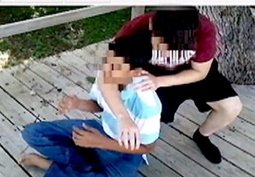By SYDNEY LUPKIN
David Nuno became the latest teenager to die in a freak accident this week trying to duplicate a stunt he saw on YouTube called the “good kids’ high.”
Nuno, 15, and his two friends were watching a YouTube video of how to pass out on purpose before trying it out on Tuesday, Chula Vista Police Capt. Gary Wedge said.
Just like in the video, Nuno was standing before he lost consciousness. When he fell forward, he crashed onto an empty drinking glass and broke it with his collarbone, allowing the shard to slice through his interior and exterior jugular arteries.
His friends didn’t see the blood until they rolled him over, prompting one to race down the stairs to find Nuno’s father, Wedge said. As Nuno regained consciousness, he realized he was bleeding and ran down the stairs just as his father was running up to help him. As his father applied pressure to the wound with a towel, Nuno collapsed on the floor.
Emergency responders arrived and tried to stop the bleeding, but Nuno’s pulse disappeared. They performed CPR, but he died shortly after he got to the hospital, Wedge said.
“Anytime a teen dies, it’s tragic,” Wedge said, adding that he’d never seen anyone try to asphyxiate himself to get high before Tuesday, but he’s learned “it’s much more common than people realize.”
Nuno’s death isn’t the first like it – not even the first this month. A 12-year-old suffocated to death in Wisconsin trying to achieve a pass-out high last Thursday.
The Dangerous Behaviors Foundation asked victims’ parents to report choking game deaths and recorded 416 fatalities as of last September.
Emergency rooms are seeing more and more teens with injuries that result from emulating things they see on YouTube videos that include the choking game, and other more innocuous sounding but deadly games such as the “cinnamon challenge,” the “salt-and-ice challenge,” “chubby bunny” and even extreme fighting.
Dr. Thomas Abramo, the chief of pediatric emergency medicine at Vanderbilt University Medical Center, said he sees all of it in his ER. Although teens have acted on risky behavior fads throughout his 30-year career, he said he’s seeing trends catch on faster than ever before, and he thinks it’s because of YouTube and social media.
“If you get one kid doing it, you tend to see more kids doing it,” said Abramo, who said two of his patients have died playing the choking game. “The spread of the event is definitely faster.”
One challenge that scares Abramo involves being hit on the head with a bench or a folding chair to “see if you can take it,” he said. A lot of the time, they can’t.
“Fractures, concussions, lacerations,” Abramo said. “Just the things you would think would happen.”
“Once you see some of these videos, you go, ‘Oh my God,'” the doctor said. The “Darwin award” videos, which involve varying dangerous challenges, are the worst he’s seen. “Survival of the stupidest. I can’t believe it happens. It defies logic,” Abramo said.
YouTube’s guidelines prohibit content that encourages dangerous behavior, but 72 hours of new video are uploaded each minute, according to YouTube statistics, making it difficult to prevent dangerous content being posted.
“We count on our users to flag content they believe violates the rules,” a YouTube spokesman said. “We review flagged videos around the clock and remove all those that violate our policies.”
Dr. Alan Hilfer, a child psychologist at Maimonides Medical Center, said he thinks the existing videos validate risky behavior for teens and give them a way to get notoriety if they post a video. He said he hears a lot about YouTube’s amateur ultimate fighting videos, which show teen fights with are no rules — just bare knuckles.
“A kid showed me his video of that, and it was appalling,” he said. “These kids were beating each other to a pulp, and kids were standing around and cheering until somebody gave up.”
Hilfer, who has worked as a child psychologist for four decades, said videos also validate anorexia and cutting by making them seem normal.
“When I first came into the field, nobody cut,” he said.
However, Dr. Carol Bernstein, a psychiatry professor at New York University’s Langone Medical Center, said she doesn’t think YouTube alone is to blame for teens engaging in challenges that could seriously injure them because many factors are involved. She said other environmental factors, physiology, and temperament contribute to a child’s decision to emulate a video.
“Stress here should be on knowing our children, watching behaviors and having conversations with them,” Bernstein said. “There’s no substitute for parents and teachers who are engaging with their kids in general.”
She said if parents discover their child is hurting himself or herself in any way, they should have a conversation with that child. If necessary, she said parents should reach out to a pediatrician to see if he or she should be evaluated by a child psychologist.
“The message here if for parents to not be afraid to have conversations with their children,” she said. “We need to do that.



